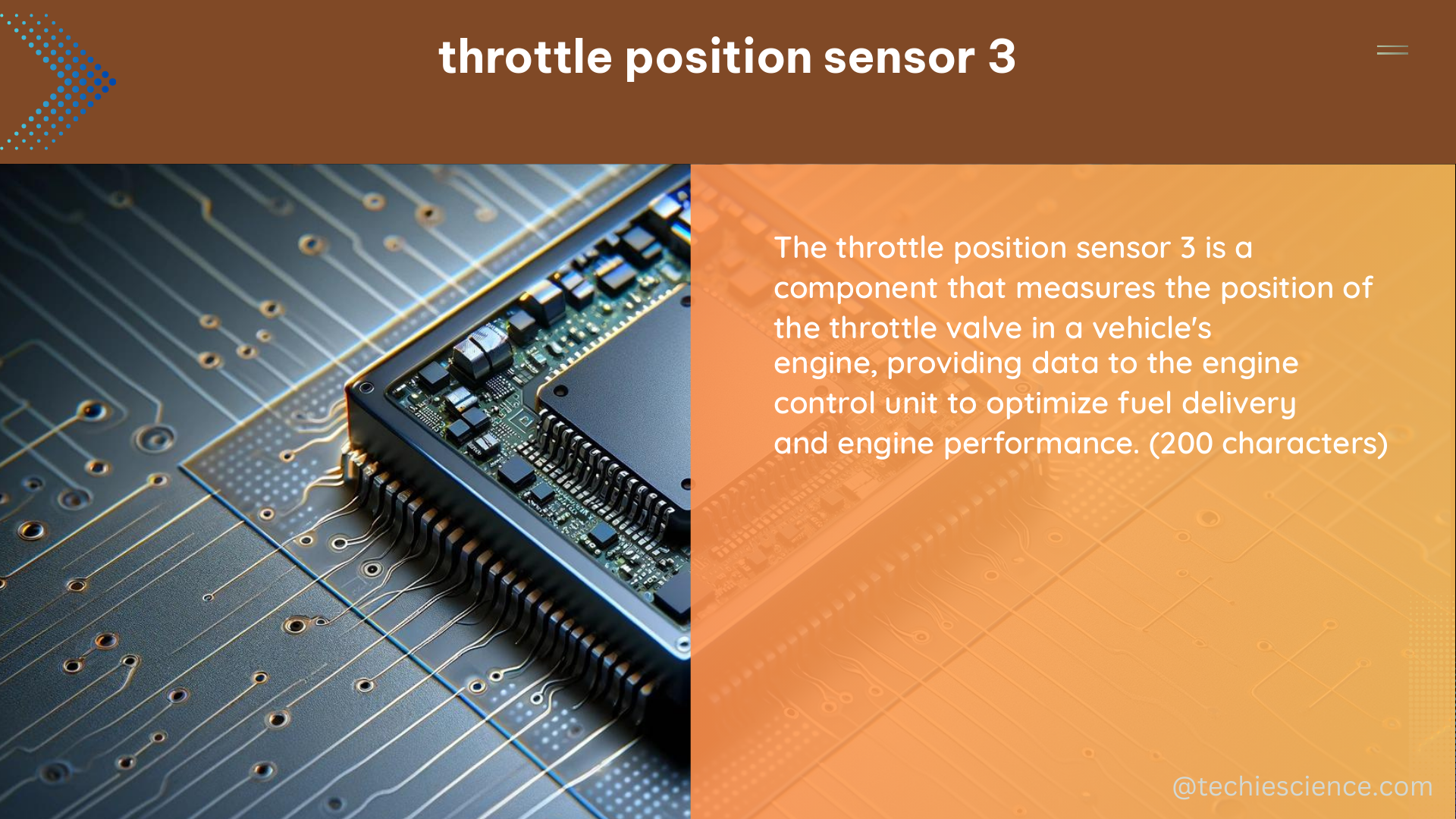The throttle position sensor (TPS) is a critical component in modern automotive engines, providing real-time feedback to the engine control unit (ECU) on the position of the throttle valve. While the previous information did not delve into the specifics of throttle position sensor 3, this comprehensive guide will explore its role, functionality, and technical details to help you better understand this essential automotive component.
Understanding Throttle Position Sensor 3
Throttle position sensor 3 is a specialized sensor that measures the angular position of the throttle valve in an internal combustion engine. This information is crucial for the ECU to optimize engine performance, fuel efficiency, and emissions control. Unlike the more commonly known throttle position sensor 1 and 2, throttle position sensor 3 provides an additional layer of redundancy and precision in the engine’s air intake management system.
Key Features of Throttle Position Sensor 3
-
Redundancy: Throttle position sensor 3 is typically installed alongside the primary throttle position sensors (TPS1 and TPS2) to provide a backup signal in case of sensor failure or discrepancies. This redundancy ensures the ECU always has accurate throttle position data, even in the event of a single sensor malfunction.
-
Precision: Throttle position sensor 3 is designed with advanced sensing technology, often utilizing Hall-effect or potentiometric principles, to deliver highly accurate and linear throttle position measurements. This precision is crucial for the ECU to make fine-tuned adjustments to fuel injection, ignition timing, and other engine parameters.
-
Adaptive Calibration: Many modern throttle position sensor 3 designs incorporate adaptive calibration algorithms that continuously monitor and adjust the sensor’s output to compensate for wear, temperature changes, and other environmental factors. This ensures the sensor maintains its accuracy and reliability over the vehicle’s lifetime.
-
Diagnostic Capabilities: Throttle position sensor 3 is integrated into the vehicle’s onboard diagnostics (OBD) system, allowing the ECU to monitor the sensor’s performance and detect any faults or discrepancies. This information can be accessed by technicians using diagnostic tools, enabling efficient troubleshooting and maintenance.
Technical Specifications of Throttle Position Sensor 3
-
Voltage Range: Throttle position sensor 3 typically operates within a voltage range of 0.5 to 4.5 volts, with the voltage output directly proportional to the throttle valve’s angular position.
-
Resistance Range: The sensor’s internal resistance can vary from 1 to 6 kΩ, depending on the specific design and manufacturer.
-
Angular Range: Throttle position sensor 3 is designed to measure the throttle valve’s angular position within a range of 0 to 90 degrees, corresponding to the fully closed and fully open positions, respectively.
-
Linearity: The sensor’s output voltage should exhibit a linear relationship with the throttle valve’s angular position, with a typical linearity error of less than 2%.
-
Response Time: Throttle position sensor 3 is required to have a fast response time, typically less than 10 milliseconds, to ensure the ECU receives real-time throttle position data for optimal engine control.
-
Operating Temperature: The sensor is designed to operate reliably within a wide temperature range, typically from -40°C to 125°C, to withstand the harsh environmental conditions found in automotive applications.
-
Durability: Throttle position sensor 3 is engineered to withstand vibrations, shocks, and other mechanical stresses encountered in vehicle operation, with a typical lifespan of 10 years or more.
Throttle Position Sensor 3 in Automotive Applications

In the automotive industry, throttle position sensor 3 plays a crucial role in the engine management system, working in conjunction with the ECU to optimize engine performance, fuel efficiency, and emissions control.
Engine Performance Optimization
The ECU uses the data from throttle position sensor 3, along with other engine sensors, to precisely control the air-fuel ratio, ignition timing, and other engine parameters. This optimization ensures the engine delivers the desired power output while maintaining efficient and clean combustion.
Fuel Efficiency and Emissions Control
By monitoring the throttle position, the ECU can adjust the fuel injection and ignition timing to minimize fuel consumption and reduce harmful exhaust emissions. Throttle position sensor 3 is a key component in the engine’s closed-loop control system, which continuously monitors and adjusts the engine’s operation to meet stringent emissions regulations.
Diagnostic and Troubleshooting
Throttle position sensor 3 is integrated into the vehicle’s onboard diagnostics (OBD) system, allowing the ECU to monitor the sensor’s performance and detect any faults or discrepancies. This information can be accessed by technicians using diagnostic tools, enabling efficient troubleshooting and maintenance of the engine management system.
Conclusion
Throttle position sensor 3 is a critical component in modern automotive engine management systems, providing redundancy, precision, and adaptive calibration to ensure optimal engine performance, fuel efficiency, and emissions control. By understanding the key features and technical specifications of this sensor, automotive technicians and enthusiasts can better diagnose and maintain their vehicle’s engine management system for improved reliability and performance.
References:
- Administrative Changes to AETC TTP11-1, Employment of Air Education and Training Command F-15C/D Aircrew Weapons Systems, 4 SEPTEMBER 2009, https://static.e-publishing.af.mil/production/1/aetc/publication/aetcttp11-1/aetcttp11-1.pdf
- DEPARTMENT OF DEFENSE STANDARD PRACTICE, MIL-STD-881F, https://cade.osd.mil/Content/cade/files/coplan/MIL-STD-881F_Final.pdf
- CONTROL VALVE HANDBOOK, Emerson, https://www.emerson.com/documents/automation/control-valve-handbook-en-3661206.pdf
- Bosch Automotive Handbook, 9th Edition, Robert Bosch GmbH, 2014.
- SAE International, “Throttle Position Sensor Characterization,” SAE Standard J1843, 2015.
- ISO 15031-5:2011, “Road vehicles — Communication between vehicle and external equipment for emissions-related diagnostics — Part 5: Emissions-related diagnostic services,” International Organization for Standardization, 2011.

The lambdageeks.com Core SME Team is a group of experienced subject matter experts from diverse scientific and technical fields including Physics, Chemistry, Technology,Electronics & Electrical Engineering, Automotive, Mechanical Engineering. Our team collaborates to create high-quality, well-researched articles on a wide range of science and technology topics for the lambdageeks.com website.
All Our Senior SME are having more than 7 Years of experience in the respective fields . They are either Working Industry Professionals or assocaited With different Universities. Refer Our Authors Page to get to know About our Core SMEs.